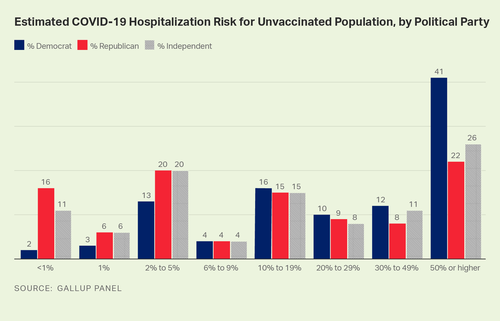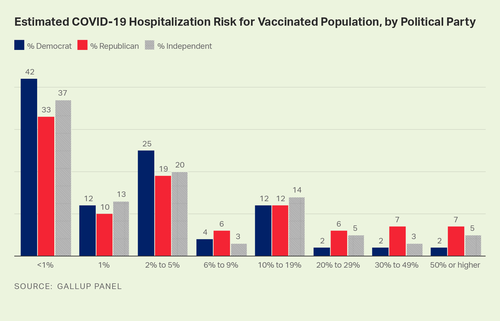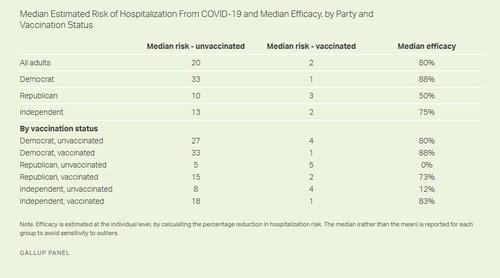US Adults' Estimates Of COVID Hospitalization Risk Depends On Party, Vaxx Status: Gallup
By Jonathan Rothwell of Gallup
The American public's understanding of the effectiveness of COVID-19 vaccines may have been put to the test in recent weeks as national public health leaders openly debated whether a booster shot is needed for the general population. Meanwhile, a large gap in vaccination rates persists between Democrats and Republicans, possibly reflecting partisans' different views on the relative risks of COVID-19 versus the vaccines.
In August, Gallup surveyed over 3,000 U.S. adults on their understanding of the likelihood of hospitalization after contracting COVID-19 among those who have versus have not been vaccinated. The results show that most Americans overstate the risk of hospitalization for both groups: 92% overstate the risk that unvaccinated people will be hospitalized, and 62% overstate the risk for vaccinated people. At the same time, U.S. adults are fairly accurate at estimating the effectiveness of vaccines at preventing hospitalization, with the median respondent putting it at 80%.
Democrats provide much higher vaccine efficacy estimates than Republicans (88% vs. 50%), and unvaccinated Republicans have a median vaccine efficacy of 0%, compared with 73% for vaccinated Republicans.
Background
Throughout the COVID-19 pandemic, political affiliation has been a strong predictor of attitudes and behaviors related to disease risks and mitigation. Gallup's monthly tracking of adult (18+) vaccination rates in the U.S. reveals a deep political divide. As of September 2021, 92% of Democrats reported having had at least one dose of a COVID-19 vaccine compared with 56% of Republicans.
Previous Gallup research has found that the American public has a poor understanding of the true risks associated with the COVID-19 pandemic and that misperceptions vary by political party. In December 2020, through the Franklin Templeton-Gallup Economics of Recovery Study, we asked 5,000 U.S. adults: "As far as you know, what percentage of people who have been infected by the coronavirus needed to be hospitalized?" Only 18% provided the correct answer, which at that time was between 1% and 5%, and a higher percentage of Republicans (26%) gave the correct response than did Democrats (just 10%). Likewise, experimental research from Gallup and Franklin Templeton found that providing people information about high vaccine efficacy led to greater acceptance of the vaccine.
Data from Gallup's most recent COVID-19 Panel survey, in August, is especially relevant to the public's understanding of vaccine efficacy; in recent weeks, the Biden administration, health officials, and many in the media have expressed concerns about breakthrough infections stemming from the Delta variant of SARS-CoV2, pointing to rising infections, hospitalizations and deaths. On Aug. 18, the Department of Health and Human Services announced that it was making plans for administering booster shots to people who are already vaccinated, pending FDA approval. This caused some debate among experts. For example, on September 13, medical scholars published an analysis in a leading journal concluding that "Current evidence does not appear to show a need for boosting in the general population." Four days later, on September 17, a U.S. Food and Drug Administration panel rejected Pfizer's application for broad emergency use of a third dose, opting instead to restrict such authorization for only select groups of higher-risk persons.
In light of these debates, Gallup tested public understanding of the efficacy of the COVID-19 vaccines by asking 3,158 U.S. adults two questions during a field period of August 16-22. The items tested respondents' overall assessment of COVID hospitalization risks facing vaccinated and unvaccinated individuals, allowing researchers to calculate the implied efficacy of vaccines.
The items were the following:
- As far as you know, what percentage of unvaccinated people have been hospitalized due to the coronavirus?
- As far as you know, what percentage of fully vaccinated people have been hospitalized due to the coronavirus?
The implied efficacy of vaccines is calculated by subtracting the second response from the first and dividing by the first. If a respondent answers that 10% of unvaccinated people have been hospitalized from COVID and 5% of vaccinated people, this implies a vaccine efficacy of 50%.
How the Public Understands Hospitalization Risk
For both vaccinated and unvaccinated populations, very few adults reported a correct answer, which is less than one percent. See the discussion in the appendix for details about the correct hospitalization rates and efficacy estimates. Only 8% of U.S. adults gave correct answers for the unvaccinated population and 38% for the vaccinated population.
Partisanship was a strong predictor of accuracy, but party accuracy varied by whether the respondent was assessing the risk of the vaccinated or unvaccinated populations.
For unvaccinated hospitalization risk, 2% of Democrats responded correctly, compared with 16% of Republicans. In fact, 41% of Democrats replied that at least 50% of unvaccinated people have been hospitalized due to COVID-19.
By contrast, Democrats were more likely to estimate hospitalization risk for the vaccinated population correctly: 42% of Democrats compared with 33% of Republicans correctly reported that less than one percent of vaccinated people have been hospitalized. Very few respondents thought the risks exceed 50% (only 2% of Democrats and 7% of Republicans).
Public Understanding of Vaccine Efficacy
The relative reduction of risk from vaccination is known as the efficacy estimate. U.S. CDC data suggest that vaccines are roughly 99% effective at reducing hospitalizations. Careful studies that attempt to compare people living in the same area who face similar risks find efficacy rates around 95%, even against Delta variant, for the most common vaccines found in the United States (Pfizer, Moderna).
We used individual responses to the items on hospitalization probabilities for vaccinated and unvaccinated people to calculate an implied efficacy rate, which is the percentage reduction in risk for the vaccinated group. Again, partisanship is a strong predictor of the accuracy of these estimates. U.S. adults estimated a median efficacy rate of 80%, which is close to the actual rate. Democrats, however, were even more accurate, with a median efficacy rate of 88%. Republicans, however, expressed an efficacy rate of only 50%.
Vaccination status was also a strong predictor of efficacy estimates. Unvaccinated Republicans reported risk rates that implied zero benefit of vaccination -- an efficacy rate of 0%. By contrast, vaccinated Republicans reported an estimated efficacy of 73%, much closer to the truth. Unvaccinated Independents were also far off (12% efficacy), but vaccinated independents were close (83%) to Democrats. For Democrats, vaccination status made little difference, however. Unvaccinated Democrats still reported 80% efficacy rates. Given previous studies on the effects of the media and information during COVID, one possible reason is that Democrats are more consistently exposed to information that favorably portrays vaccine efficacy.
Discussion
Democrats are more likely to overstate hospitalization risks for unvaccinated people, which may fuel efforts, often led by Democratic Party leaders, to enforce both mask and vaccine mandates. At the same time, Republicans overstate risks to vaccinated people, leading to very low vaccine efficacy estimates. This may be one of the reasons that so many Republicans have been reluctant to get the COVID-19 vaccine. Previous research links these behavioral patterns to differences in information exposure. If so, vaccine acceptance is unlikely to significantly increase among Republicans until their trusted media or other information sources emphasize the benefits of vaccination.
https://ift.tt/3ogNfE3
from ZeroHedge News https://ift.tt/3ogNfE3
via IFTTT





0 comments
Post a Comment